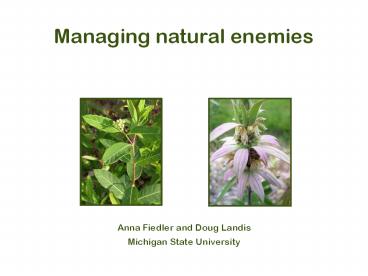Managing natural enemies - PowerPoint PPT Presentation
Title:
Managing natural enemies
Description:
Title: Slide 1 Author: Mary Gardiner Last modified by: buchho11 Created Date: 10/18/2005 1:08:08 PM Document presentation format: On-screen Show Company – PowerPoint PPT presentation
Number of Views:209
Avg rating:3.0/5.0
Title: Managing natural enemies
1
Managing natural enemies
Anna Fiedler and Doug Landis Michigan State
University
2
Ecosystem Services
3
Biological Control
- Use of natural enemies to keep unwanted pest
populations low
4
Three types of Natural Enemies
- Predators eat many prey in a lifetime, feeding
both as young and as adults. - Parasitoids specialized insects that develop as
a young in one host, eventually killing it. - Pathogens nematodes, viruses, bacteria, fungi,
protozoans.
5
Types of Biological Control
- Classical introduction of non-native natural
enemy to control a pest population. - Augmentative periodically increase natural enemy
population with an artificially reared release. - Conservation maintain or enhance existing
natural enemy populations.
6
What do beneficial insects need?
- Alternate host/prey
- Shelter
- Moderated microclimates
- In-season refuges
- Overwintering sites
- Food
- Nectar
- Pollen
- Sap, honeydew
7
Historical Landscapes
Diverse habitats provide - Biodiversity -
Pest suppression - Pollination
8
Native Plant Project Goals
Use native plants to provide beneficial insects
with nectar and pollen. Decrease pesticide use
and increase pollination.
9
Exotic Plants
- Benefits
- Reliable seed or plant sources
- Prolific floral display
- Previous success in other locations
- Disadvantages
- Do not enhance native biodiversity
- May be invasive
10
Native Plants
- Benefits
- Enhance native biodiversity
- Re-creation of imperiled habitats
- Less likely to be invasive
- Adapted to local climate
- Habitat permanency
- Disadvantages
- Greater initial cost
- Longer establishment time
11
(No Transcript)
12
(No Transcript)
13
(No Transcript)
14
30
25
2005 data
15
Incorporating native plants on your farm
- Use local native plants.
- Choose several colors of flowers.
- Plant flowers in clumps.
- Select flowers to provide bloom through the
season. - More flower area more beneficial insects!
- Include native grasses for structural support
16
Beneficial Insect Friendly Practices
- Provide nesting and overwintering resources.
- Avoid insecticide use.
- Provide flowers through growing season.
17
Native Plants in the Landscape
18
Select a site Analyze the site Consider
planting options Size of area Time to
flowering Cost Plan and design the
planting Plant Maintenance Short term Long term
19
(No Transcript)
20
Consider Light availability Soil type Soil
moisture Soil pH
21
Suited to conditions Variety of bloom
periods Include wildflowers and grasses Local
seed or plant source Seed vs. plant material
Michigan Wildflower Farm
22
- Yard
- Treat with roundup fall or mid-spring
- Smother 2-3 months when growing
- Typical ag field
- 1 year fallow
- Repeated light tillings
- Weedy site (old field)
- Burn or plow
- 1 year fallow
23
(No Transcript)
24
(No Transcript)
25
Weed your native planting OR 1) Mow a seeding
2-4 times in year one 1-2 times in year two
2) Burn or mow annually
26
Native Plants to Enhance Beneficial Insects
website
E-2985
www.nativeplants.msu.edu
E-2973
E-2949
27
Contact a native plant producer Acorus Native
Plant Nursery www.ecologyart.com Native Plant
Source www.nativeplantsource.com may not be
local seed
28
Acknowledgements
Research collaborators Bill Schneider, Wildtype
Native Plant Nursery Esther Durnwald, MI
Wildflower Farm Jerry Stewart, Native
Connections Gene Vogel, Richard Stuckey Rufus
Isaacs, Julianna Tuell USDA NRCS Ingham County
Soil Conservation District MSU
IPM Identification support Gary Parsons Dr.
Debra Trock Undergraduate research
assistants Jessica Steffen Dawn
Richards Emily Knoblock
Funding Support
USDA Sustainable Agriculture Special Grant
www.nativeplants.msu.edu

